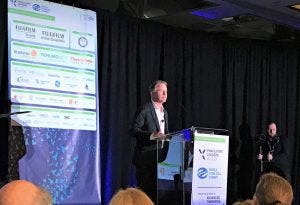
Manufacturing issues and a scarcity of new commercial products leave predictions that 10-20 cell and gene therapy approvals each year by 2025 somewhat fanciful, says Dark Horse Consulting.
In his plenary address at the Phacilitate conference yesterday, Anthony Davies, founder of cell and gene therapy specialist firm Dark Horse Consulting, reflected on the difficulties the sector has faced since the high of 2017 when three products achieved US Food and Drug Administration (FDA) approval: Kymriah (tisagenlecleucel) and Yescarta (axicabtagene ciloleucel), and gene therapy Luxturna (voretigene neparvovec).
“A few years ago, I introduced this evening by saying: ‘Finally the field has had the year that we’ve been saying we are going to have for years.’ That was a great year,” he told the packed room in Miami, Florida.

Dark Horse’s Anthony Davies opened the Phacilitate conference in Miami, Florida
The CAR-T therapies Kymriah and Yescarta gave hope to “patients who previously could measure their life expectancy in a small number of months,” while gene therapy Luxturna offered “hope to children whose ophthalmic deterioration was a statistical certainty,” he added.
With these breakthroughs, positivity was high and in January 2019 then FDA Commissioner Scott Gottlieb predicted in an agency statement that there will be upwards of 200 regenerative medicine IND submissions from 2020, and by 2025 the agency will be approving 10 to 20 cell and gene therapy products a year.
“I think 200 INDs is doable this year, but INDs do not cure patients,” Davies said. “And I think if we’ve struggled with getting three commercial approvals in the years after that first year when three commercial approvals were made, so getting 10-20 in five years from now is going to be extremely challenging.”
Stalled industry
Since that breakthrough year, the industry has been hot by “bad news” and a lack of commercial products. Novartis/AveXis’ Zolgensma (onasemnogene abeparvovec) and bluebird’s Zynteglo (autologous CD34+ cells encoding βA-T87Q-globin gene) were approved by the FDA last year, while Takeda’s allogeneic cell therapy Alofisel (darvadstrocel) “has been approved to a certain extent in Europe.”
While Davies described the approval of Zolgensma, at a cost of $2.1 million, as “groundbreaking,” he noted it has been overshadowed by a scandal involving data falsification during the approval process.
He also noted that Zynteglo’s success has been muted by multiple manufacturing problems which has delayed launch.
Meanwhile, pioneer product Kymriah continues to suffer from manufacturing difficulties, and Novartis seems to be struggling with fixing them, Davies suggested.
“At JP Morgan [Healthcare Conference] it was announced that for 10% of patients no shipment of drug is made, and for a very significant minority of patients’ shipment is made with out-of-spec product for which Novartis cannot charge,” he told the conference
He added that at the investor conference last week, Novartis CEO Vasant Narasimhan “said that they had made great process in identifying the manufacturing issues and were negotiating their resolution with the FDA.
“This was exactly the same statement he made at JP Morgan the year before that.”
Reasons to be cheerful
But despite the slowdown in commercialization and industry’s challenges, Davies said there remains a lot to be positive about.
“Everything that I said reflects the extreme difficulty in bringing this class of therapeutics to market. If these therapeutics were easy to develop,p they would have been developed. If diseases were easy to cure, we wouldn’t need new therapeutics.
“Let us just use these good pieces of news and these bad pieces of news as inspiration, let’s continually remind ourselves that what we do is one of the hardest things in science or medicine at this time.”
Davies was not alone in his views.
Speaking Wednesday, Robert Preti, CEO of Hitachi Chem Advanced Therapeutic Solutions, admitted the industry is behind where he thought it would be when he began his career 37 years ago, but said he was not too worried.
“I want to commend this industry on what we have achieved for patients,” he said, noting the difficulty in developing and making these therapies. He also highlighted that with over 1,000 regenerative therapies in development, problems will eventually be ironed out and cell and gene therapies will make the widespread impact intended.
About the Author
You May Also Like

schedl_b_and_w.jpg?width=100&auto=webp&quality=80&disable=upscale)
schedl_b_and_w.jpg?width=400&auto=webp&quality=80&disable=upscale)



